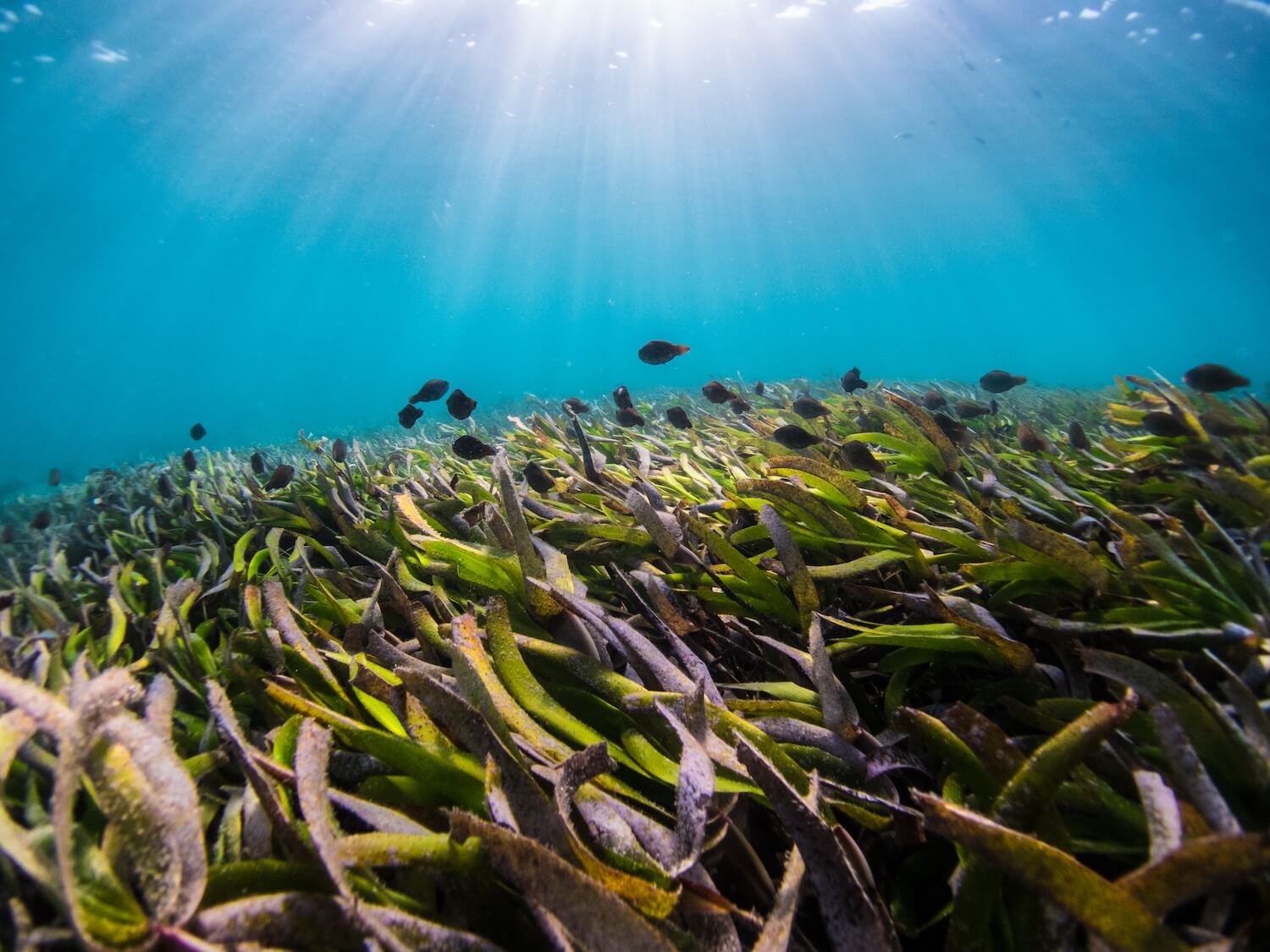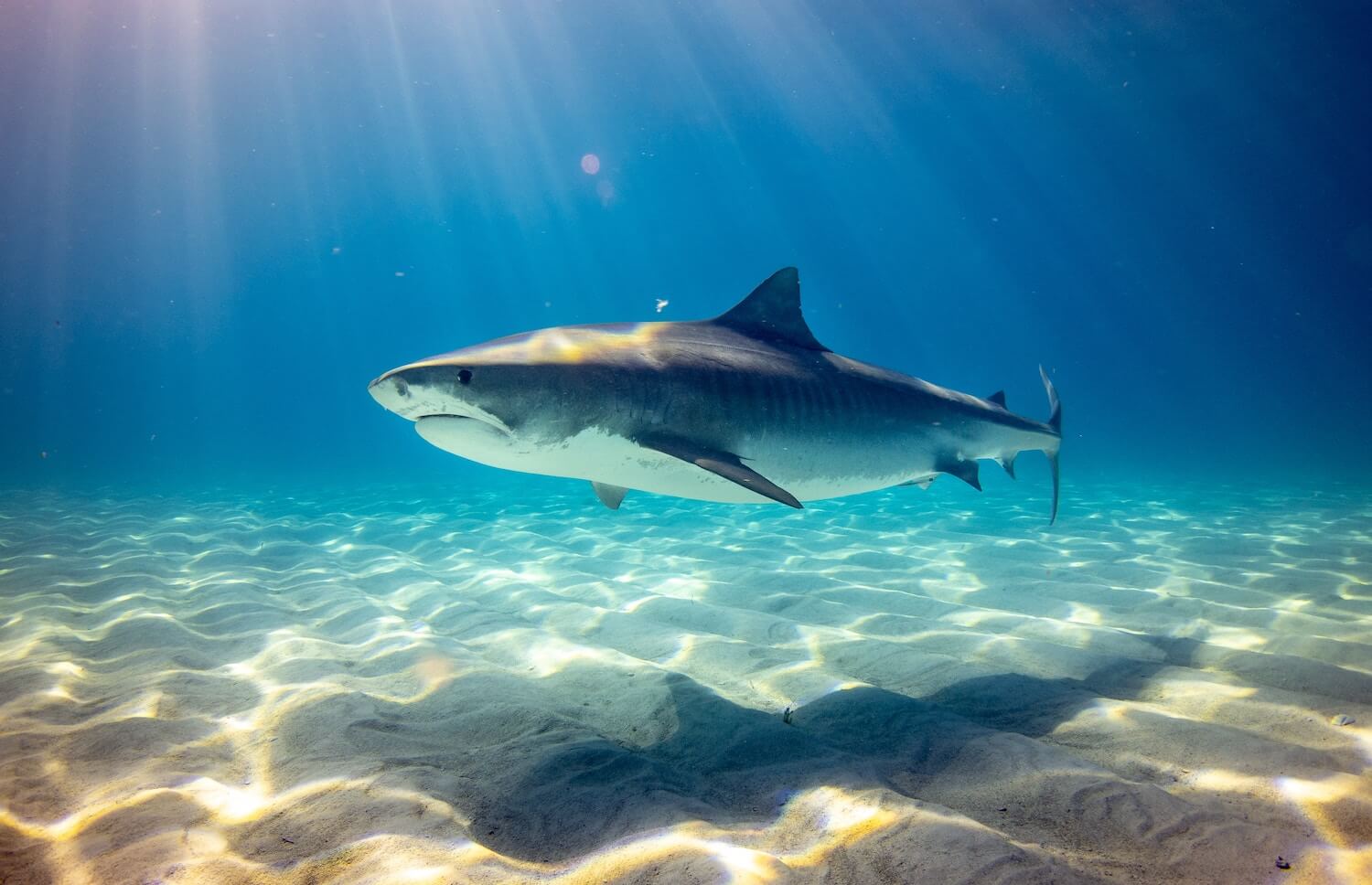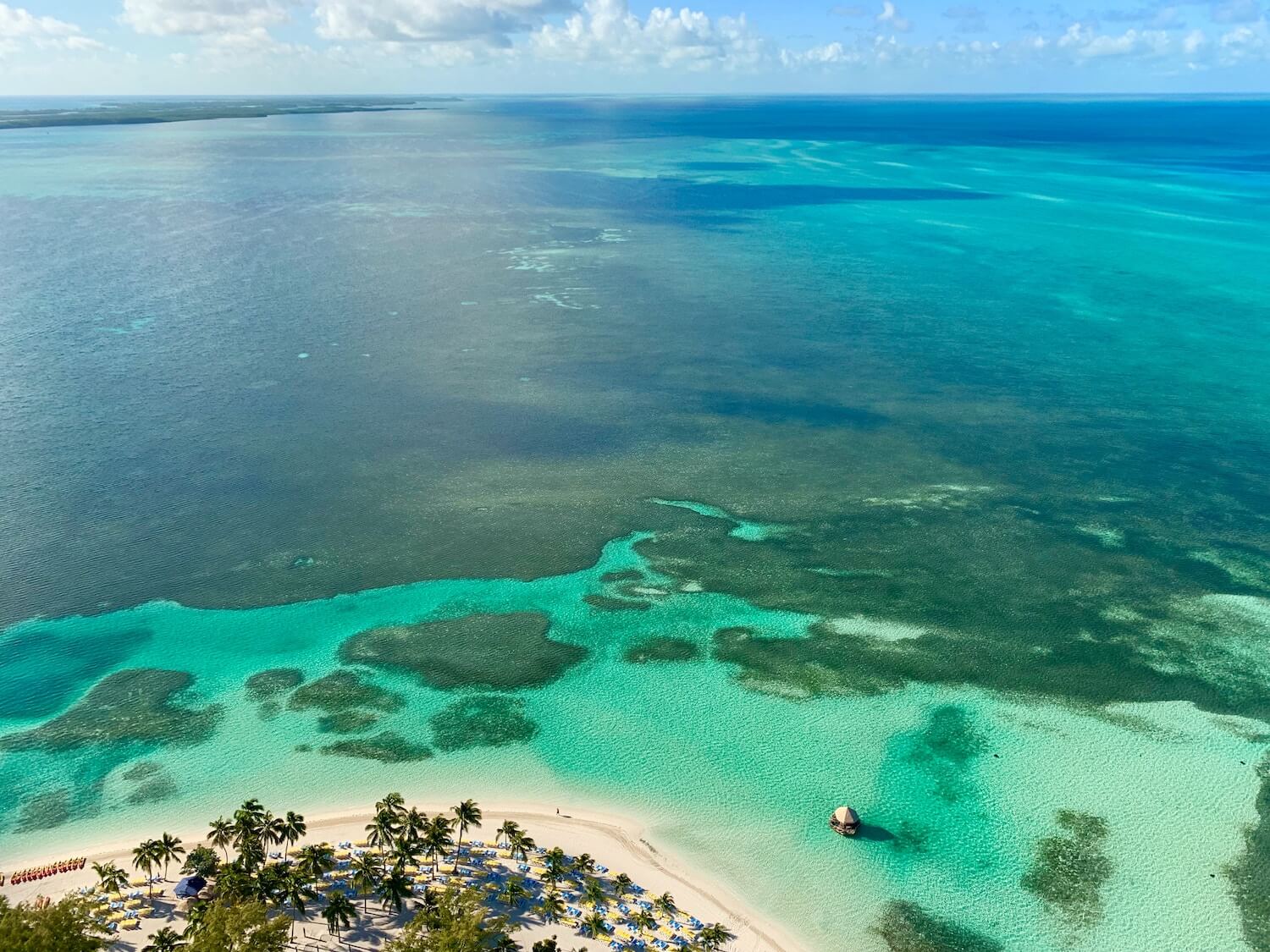Gallagher, A.J., Brownscombe, J.W., Alsudairy, N.A., et al. (2022) Tiger sharks support the characterization of the world’s largest seagrass ecosystem. Nature Communications, [online] 13(1), p.6328. doi:https://doi.org/10.1038/s41467-022-33926-1.
Published May 9th, 2023
The Bahamas is home to the Earth’s largest seagrass ecosystem, a major blue carbon sink and important asset in climate change mitigation. However, the known extent of seagrass beds is limited, inhibiting effective conservation of these environments. Tagged tiger sharks are being used as a new data source for mapping due to their tight association with seagrass beds, which could lead the way for time- and cost-effective marine spatial data collection.
Seagrasses are a group of marine grass species, unique as the only flowering plants found in the ocean. Despite being a widely underrepresented ecosystem, seagrass meadows are an essential aspect of healthy oceans and marine food webs.
As well as providing a nursery habitat for hundreds of fish and crustacean species, a feeding ground for large marine fauna such as manatees and turtles, and a water purification service, seagrasses are an effective carbon sink and have huge potential to reduce atmospheric carbon dioxide levels.

Seagrass beds sequester carbon faster than rainforests and are found across the globe. They store carbon within their biomass while simultaneously binding seabed sediments, preventing shallow coastal erosion and promoting clear and oxygenated waters. This is an important ecosystem service for many interdependent ecosystems, such as reefs and mangrove forests. Seagrass meadows additionally support around 20% of the planet’s major fisheries, making them fundamental for global food security.
Degradation and loss of seagrass meadows is a global problem that has been accelerating over recent decades. Seagrass is not only vulnerable to nutrient loading by marine pollution, such as agricultural runoff and untreated sewage, but also to seabed scarring by anchors, which damage the root system. Such disturbances allow pathogens to infect the plants, or tear the plant from the seabed, causing irreparable damage.
Due to the many important functions this habitat provides, restoration of seagrass meadows should be at the forefront of marine conservation efforts. However, seagrass is often mistaken for seaweed and removed by coastal developments, as tourists prefer a ‘clean’ sea to swim in. In reality, this makes the water lose its clarity, as the seagrass—the filtering system—has been removed.
‘Restoration of seagrass meadows should be at the forefront of marine conservation efforts.’
The lack of knowledge surrounding the locality and characteristics of global seagrass beds is another large barrier preventing effective conservation. Precise mapping of seagrass beds is needed to fight their case in marine policy to achieve effective protection in vital zones.
Ground-truthing (manual mapping by divers and snorkelers) is an expensive and time-consuming activity. For this reason, most mapping is done through remote sensing, though the overlap between seagrass and marine algae makes deciphering images difficult, often leading to high levels of inaccuracy.
Recently, a new technology has been trialled as a method of seagrass mapping: camera tags. In the Bahama Banks, an expansive area of clear and shallow tropical water, camera tags have been attached to native tiger sharks to help gauge the extent of local seagrass, predicted to be the largest in the world.

Tiger sharks are highly mobile marine fish, which inhabit shallow seagrass ecosystems and provide a potential ground-truthing data source. Due to their speed and ability to cover huge areas, these sharks can effectively map the seagrass bed for a fraction of the cost and effort of human divers.
Selected sharks were equipped with satellite tags to monitor the range and area covered by individuals, and biologging cameras to record seafloor imagery. This allows habitat classification and identification of seagrass at depths not easily accessible by divers.
Tiger sharks were found to cover upwards of 50 kilometres per day, compared to only a few metres by divers. This also provided a constant stream of data, as utilising the sharks avoided patchy data provided by divers, limited by oxygen, as well as other physical or practical restraints.
‘Restoration of seagrass meadows should be at the forefront of marine conservation efforts.’
Data provided from the shark cameras was collated with human and remote sensing observations to buffer inaccuracies, resulting in a mapped extent 10 times that of previous ability. This allowed for the identification of seagrass species and characterisation of the meadows, including plant density, canopy height and exact coverage.
This has provided vital data that will inform future marine policy and restoration efforts, such as no-anchor zones, which are essential for the effective conservation of the Bahama Banks seagrass meadow. It has also highlighted the potential resource that marine megafauna provide for rapid marine ecosystem mapping, a new concept which has not yet been fully explored.
The mapping of the Bahama Banks seagrass bed will lay the groundwork for assessing the ecological complexities and conservation needs of the ecosystem, enabling appropriate research and protection methods, such as legislation, to be employed. This may also initiate the use of sharks and other large marine fauna as research assistants in future mapping projects, across the global oceans, as it presents an affordable and rapid shortcut to urgently needed data.

The Bahama Banks seagrass bed is estimated, based on this data, to be around 90,000 square-kilometres. Presenting this data as solid evidence through published research is a huge achievement, propelling conservation efforts and supporting new protection proposals with a high chance of success.
The loss of seagrass across the globe is of huge concern. These ecosystems are an essential source of oxygen, as well as fulfilling the function of coastal protection, provision of vital habitat, a sediment binder, water purifier, and carbon sponge.
The sheer extent of vulnerable habitat, as uncovered by this study, highlights the need for more innovative research, such as partnership with native marine megafauna, to aid the advancement of marine habitat mapping and subsequent protection.
Featured Image: Jett Britnell | Ocean Image Bank
Gallagher, A.J., Brownscombe, J.W., Alsudairy, N.A., et al. (2022) Tiger sharks support the characterization of the world’s largest seagrass ecosystem. Nature Communications, [online] 13(1), p.6328. doi:https://doi.org/10.1038/s41467-022-33926-1.